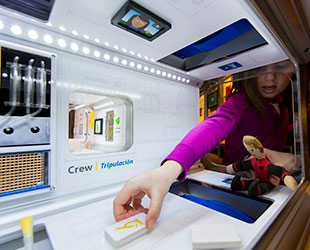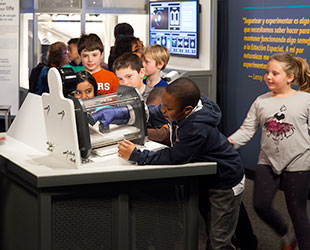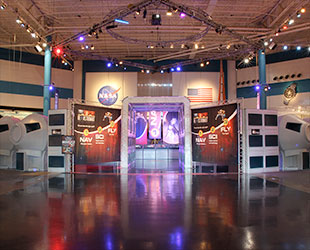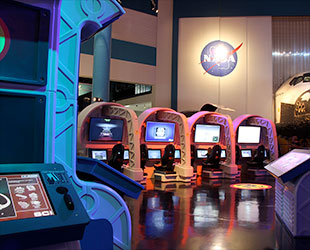October 30, 2015 — Two museums' new exhibits offer the public a chance to "Be the Astronaut" as they "Journey to Space."
In Los Angeles, the California Science Center has debuted "Journey to Space," a hands-on, climb-aboard experience at what it takes to live and work off the Earth.
And in Texas, Space Center Houston recently opened "Be the Astronaut," a multimedia exhibit that takes visitors on trips to the moon, Mars, asteroids, Jupiter and beyond.
From exploring the International Space Station to landing on multiple worlds, these new, separate attractions feature authentic artifacts, replica space hardware and interactive displays to entertain and educate children and the general public about the physics, science and technology needed to support human space exploration, both now and in the future.
Journey to Space
In the microgravity environment on the International Space Station, astronauts need to adapt to there being no up or down. At the California Science Center, gravity, of course, could not be turned off, so the equipment-lined walls of its full-scale replica of the Destiny laboratory rotate.
The effect challenges guests' sense of orientation as they take a virtual tour of the lab module, guided by astronauts on video who have worked on the real orbiting outpost.

A model of the International Space Station in "Journey to Space" allows guests a hands-on look at where the crew lives and work. (California Science Center/Science Museum of Minnesota) |
The walkthrough module is just one the new experiences awaiting visitors in "Journey to Space," the companion to the large-format movie of the same name, designed by the Science Museum of Minnesota in partnership with NASA's space station office at the Johnson Space Center, as well as the California Science Center and partner museums.
"The 'Journey to Space' exhibition and 3-D film explores the history and bright future of human space travel, along with the risks and innovative solutions involved," said Jeff Rudolph, the president of the California Science Center, in a statement. "Presenting the exhibition and film together [has] a richer educational impact, giving guests a deeper understanding of the space exploration challenges facing the next generation."
Through games and multimedia components, guests find out how astronauts eat, sleep and even use the bathroom. They encounter the difficulties of working in space — from operating a robotic arm on the space shuttle, to managing the limited power to keep life support systems running, to discovering why working in a pressurized spacesuit glove in the vacuum of space is so difficult.

In "Journey to Space," students experience how working with a pressurized glove in the vacuum of space is harder than it looks. (California Science Center/Science Museum of Minnesota) |
Visitors also interact with hands-on activities that explore the science of getting to space. An experiment with water rockets, varying the amount of air and water used as fuel, allow them to see the physics of the launch, while another interactive uses drop towers, which lift items up high and then drops them in a free-fall, to demonstrate how objects behave differently in the weightless environment of space.
"Journey to Space," which debuted on Thursday (Oct. 29), is open until May 8, 2016 at the California Science Center. Tickets to the exhibit-only cost $9.75 for adults, $8.25 for seniors and college students, and $6.25 for children.
Be The Astronaut
At Space Center Houston, where "Journey to Space," the movie, is also being screened, guests can now experience planning a space mission in two dimensions and then fly it in three.
In the new "Be the Astronaut," visitors navigate through a multi-part video game that illustrates how astronauts train for missions into deep space, including driving a planetary rover and using robotic arms.

In "Be the Astronaut," guests are launched on virtual trips to the moon, Mars, the asteroids and Jupiter. (Space Center Houston) |
"The exhibition explores the solar system using interactive technology designed to inspire the next generation," said Richard Allen, Space Center Houston's president and chief executive, in a statement. "Visitors control the action for a simulated rocket launch, pilot a spaceship, and have fun playing with hands-on technologies that make [them] think about the science behind deep space exploration."
"Be the Astronaut," developed by Eureka Exhibits, uses actual planetary data to produce accurate terrains. Visitors navigate on the moon using measurements taken by the lunar orbiter laser altimeter on the Lunar Reconnaissance Orbiter. Similarly, the exhibit's game consoles, which were designed to resemble NASA's Orion spacecraft, generate the Red Planet's surface based on the observations by the space agency's Mars Reconnaissance Orbiter.
In addition to the digital elements of the exhibition, "Be the Astronaut" also displays authentic artifacts to illustrate the technology being developed for future NASA missions at the nearby Johnson Space Center.

Resembling NASA's Orion spacecraft, the "Be the Astronaut" sim stations incorporate real planetary data. (Space Center Houston) |
"I saw some EVA tools, spacewalking tools, that brought me back," said astronaut Leroy Chiao during a recent tour through the exhibition. "Those are real, by the way. Those really are the ones we use in training and in spaceflight."
"Be the Astronaut," which is making its world premiere at Space Center Houston, is now open through Jan. 3, 2016. Sponsored by the city of Webster, the exhibit is included with general admission.
